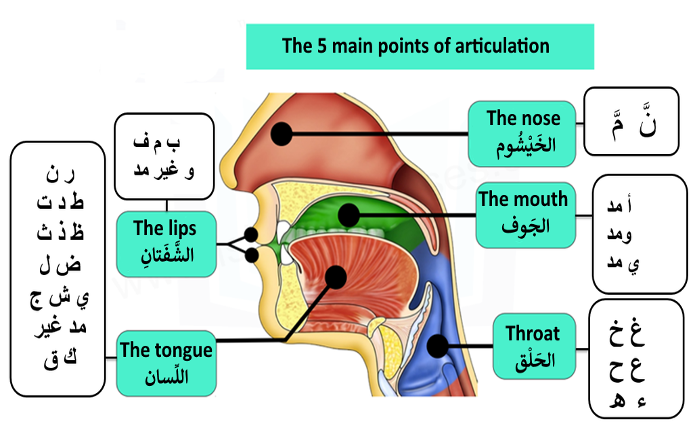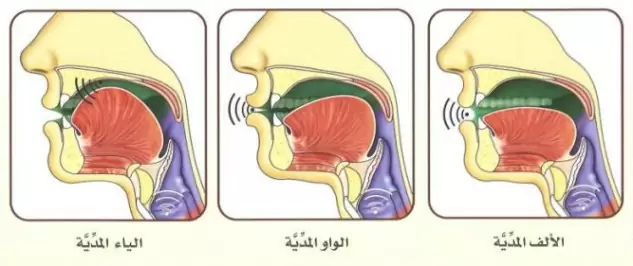Understanding the intricacies of Arabic pronunciation involves exploring the Makharij al Huruf, the articulation points where letters originate, defining their distinct sounds. Sound, a manifestation of vibrations and waves, reaches the human ear through the air, creating the rich tapestry of Arabic phonetics.
Al Makharj( The articulation point):
It is the place where a letter is pronounced, making its sound different from the sounds of other letters.
The sound:
Is a group of vibrations and waves carried in the air to the human ears.
The letter:
It is a sound that is pronounced from a specific articulation point.
Types of Makharij (Articulation Points)
- Specific Articulation Point:
- Relies on a precise location in the tongue, throat, or lips.
- Defines sounds with accuracy.
- Approximate Articulation Point:
- Independent of specific areas in the tongue, throat, or lips.
- Applies to lengthened letters, originating from the mouth and throat’s empty space.
Determining Al Makharij (Articulation Points)
To identify the articulation point of any letter (except Medd letters):
- Place a Sukoon above the letter.
- Prefix the letter with a Hamzah.
- Add any vowel above the Hamzah.
- Pronounce the letter, noting the stopped sound to determine the articulation point.
The Arabic alphabet consists of 29 letters, with the Hamza as the unnumbered letter. Understanding these pronunciations is vital in deciphering the speech system.
Enroll Now: Tajweed Course
Major Five Articulation Areas
The speech system comprises five major Makharij, each associated with specific articulation points:
1-Al Jawf (The Empty Space):
- Major area in the mouth and throat.
- Originates the three Medd (lengthened) letters.
2-The Throat:
- Divided into Adnal Halq (closest part), Wasatal Halq (middle part), and Aqsal Halq (deepest part).
- Articulates six letters, each associated with a specific part of the throat.
3-The Tongue:
- Ten articulation points for eighteen letters.
- Crucial for precision in pronunciation.
4-The Two Lips:
- Comprising two articulation points for four letters.
- Shapes sounds using lip movement.
5-The Nasal Cavity:
- Features one articulation point for Ghunnah (nasal sound).
- Adds depth to pronunciation.

Al Jawf (The Empty Space)
Al Jawf serves as a crucial area in the mouth and throat, acting as both a major space and an articulation point. Within this space, three lengthened (Medd) letters originate, each contributing a unique sound to the Arabic phonetic landscape.
1-ى (Ya’ with Sukoon):
- Pronounced after a letter with Kasrah.
- Vocal cords are open, and the middle of the tongue is raised close to the Makhraj of the letter “ya.”
2-و (Wow with Sukoon):
- Follows a letter with Dammah.
- Vocal cords are open, and the lips are rounded, similar to pronouncing the letter “wow.”
3-ا (Alif with Sukoon):
- Preceded by a letter with Fathah.
- Vocal cords are open, and the back of the tongue is lowered for the light alif, and raised for the heavy alif.

The Throat: Adnal, Wasatal, Aqsal Halq
The throat, a pivotal region for articulating specific Arabic sounds, is further divided into three distinct parts, each responsible for unique letters.

1-Adnal Halq (Closest Part):
- Articulates غ (ghain) and خ (khaa).
- Requires precision to produce distinct sounds.

2-Wasatal Halq (Middle Part):
- Gives rise to ع (ain) and ح (haa).
- Understanding the nuances of tongue placement is crucial for accurate pronunciation.

3-Aqsal Halq (Deepest Part):
- Forms the sounds of ء (hamzah) and هـ (haa).
- Mastery of articulating from the deepest part of the throat ensures clarity in pronunciation.


